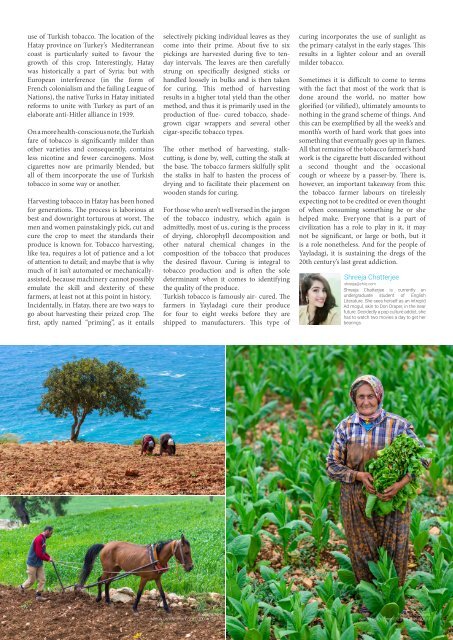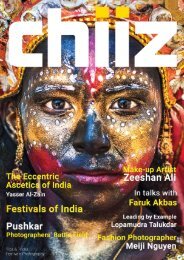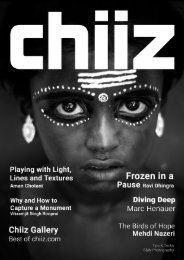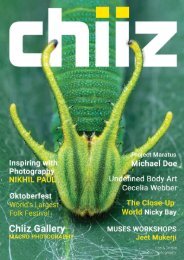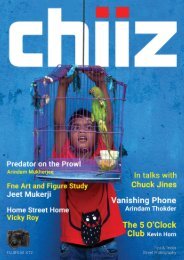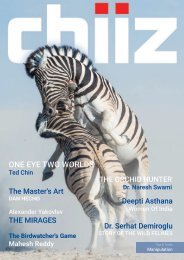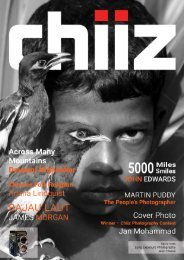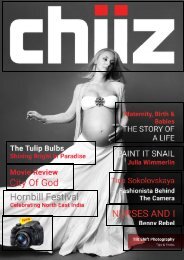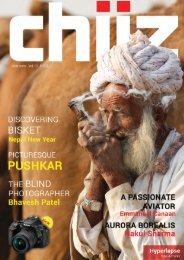Chiiz Volume 7 :Fashion Photography
When people stand in front of the mirror to have a good long look at themselves, they always hope to see a better reflection of themselves than what they have seen previously and with all this, they have grown conscious of how they appear and how comfortable they are with what they wear.Not only their clothes, but also their comfort level, express the sense of style and their conformity to the outer world.In this issue, what we have focussed on might not be the mainstream fashion and people might not get the hype that revolves around the fashion world but what we have here is something that is responsible for all that we have achieved so far in this industry. Be it natural beauty by Lynn Theisen, backstage brilliance by Ishaan Nair, or the street fashion by Rohit Arora which is now gaining popularity among the more prominent photographers.The interview with John Rawson is an eye opener. He is has been through it all andhis experiences form a great lesson for all of us. The series of Roshini Kumar with Suhail Nayyar is also a masterpiece in itself which is a true symbol of comfortable fashion statements. Rod Klein and Jorge Gonzalez’s underwater fashion photographs present an altogether different approach to see things.
When people stand in front of the mirror to have a good long look at themselves, they always hope to see a better reflection of themselves than what they have seen previously and with all this, they have grown conscious of how they appear and how comfortable they are with what they wear.Not only their clothes, but also their comfort level, express the sense of style and their conformity to the outer world.In this issue, what we have focussed on might not be the mainstream fashion and people might not get the hype that revolves around the fashion world but what we have here is something that is responsible for all that we have achieved so far in this industry. Be it natural beauty by Lynn Theisen, backstage brilliance by Ishaan Nair, or the street fashion by Rohit Arora which is now gaining popularity among the more prominent photographers.The interview with John Rawson is an eye opener. He is has been through it all andhis experiences form a great lesson for all of us. The series of Roshini Kumar with Suhail Nayyar is also a masterpiece in itself which is a true symbol of comfortable fashion statements. Rod Klein and Jorge Gonzalez’s underwater fashion photographs present an altogether different approach to see things.
Create successful ePaper yourself
Turn your PDF publications into a flip-book with our unique Google optimized e-Paper software.
use of Turkish tobacco. The location of the<br />
Hatay province on Turkey’s Mediterranean<br />
coast is particularly suited to favour the<br />
growth of this crop. Interestingly, Hatay<br />
was historically a part of Syria; but with<br />
European interference (in the form of<br />
French colonialism and the failing League of<br />
Nations), the native Turks in Hatay initiated<br />
reforms to unite with Turkey as part of an<br />
elaborate anti-Hitler alliance in 1939.<br />
On a more health-conscious note, the Turkish<br />
fare of tobacco is significantly milder than<br />
other varieties and consequently, contains<br />
less nicotine and fewer carcinogens. Most<br />
cigarettes now are primarily blended, but<br />
all of them incorporate the use of Turkish<br />
tobacco in some way or another.<br />
Harvesting tobacco in Hatay has been honed<br />
for generations. The process is laborious at<br />
best and downright torturous at worst. The<br />
men and women painstakingly pick, cut and<br />
cure the crop to meet the standards their<br />
produce is known for. Tobacco harvesting,<br />
like tea, requires a lot of patience and a lot<br />
of attention to detail; and maybe that is why<br />
much of it isn’t automated or mechanicallyassisted,<br />
because machinery cannot possibly<br />
emulate the skill and dexterity of these<br />
farmers, at least not at this point in history.<br />
Incidentally, in Hatay, there are two ways to<br />
go about harvesting their prized crop. The<br />
first, aptly named “priming”, as it entails<br />
selectively picking individual leaves as they<br />
come into their prime. About five to six<br />
pickings are harvested during five to tenday<br />
intervals. The leaves are then carefully<br />
strung on specifically designed sticks or<br />
handled loosely in bulks and is then taken<br />
for curing. This method of harvesting<br />
results in a higher total yield than the other<br />
method, and thus it is primarily used in the<br />
production of flue- cured tobacco, shadegrown<br />
cigar wrappers and several other<br />
cigar-specific tobacco types.<br />
The other method of harvesting, stalkcutting,<br />
is done by, well, cutting the stalk at<br />
the base. The tobacco farmers skilfully split<br />
the stalks in half to hasten the process of<br />
drying and to facilitate their placement on<br />
wooden stands for curing.<br />
For those who aren’t well versed in the jargon<br />
of the tobacco industry, which again is<br />
admittedly, most of us, curing is the process<br />
of drying, chlorophyll decomposition and<br />
other natural chemical changes in the<br />
composition of the tobacco that produces<br />
the desired flavour. Curing is integral to<br />
tobacco production and is often the sole<br />
determinant when it comes to identifying<br />
the quality of the produce.<br />
Turkish tobacco is famously air- cured. The<br />
farmers in Yayladagi cure their produce<br />
for four to eight weeks before they are<br />
shipped to manufacturers. This type of<br />
curing incorporates the use of sunlight as<br />
the primary catalyst in the early stages. This<br />
results in a lighter colour and an overall<br />
milder tobacco.<br />
Sometimes it is difficult to come to terms<br />
with the fact that most of the work that is<br />
done around the world, no matter how<br />
glorified (or vilified), ultimately amounts to<br />
nothing in the grand scheme of things. And<br />
this can be exemplified by all the week’s and<br />
month’s worth of hard work that goes into<br />
something that eventually goes up in flames.<br />
All that remains of the tobacco farmer’s hard<br />
work is the cigarette butt discarded without<br />
a second thought and the occasional<br />
cough or wheeze by a passer-by. There is,<br />
however, an important takeaway from this:<br />
the tobacco farmer labours on tirelessly<br />
expecting not to be credited or even thought<br />
of when consuming something he or she<br />
helped make. Everyone that is a part of<br />
civilization has a role to play in it, it may<br />
not be significant, or large or both, but it<br />
is a role nonetheless. And for the people of<br />
Yayladagi, it is sustaining the dregs of the<br />
20th century’s last great addiction.<br />
Shreeja Chatterjee<br />
shreeja@chiiz.com<br />
Shreeja Chatterjee is currently an<br />
undergraduate student of English<br />
Literature. She sees herself as an intrepid<br />
Ad mogul, akin to Don Draper, in the near<br />
future. Decidedly a pop culture addict, she<br />
has to watch two movies a day to get her<br />
bearings.<br />
Laying DeathBed<br />
NIKON D610 85mm F/8 1/400s ISO-160<br />
Honest Efforts<br />
NIKON D610 85mm F/2.2 1/2000s ISO-100<br />
Not Just Cabbages<br />
NIKON D610 85mm F/2.2 1/1000s ISO100


